When a toddler begins the process to walk he first starts by pulling himself up to standing and works on his balance. Next he holds onto something as he takes steps. Then he lets go of his support and takes his first step on his own. Next he’s walking and then running. It’s a process. Some children go from standing to walking quite quickly, while others take their time.
This process is the same with reading, writing, and arithmetic. You start with the basics and each child grows in their own time. So realize this before you start teaching your kindergartener. If your expectation is that you will be teaching and correcting your child’s basic reading and writing capabilities until 2nd, 3rd, and possibly 4th grade then it will be a happy surprise if they pick up on fluency earlier.
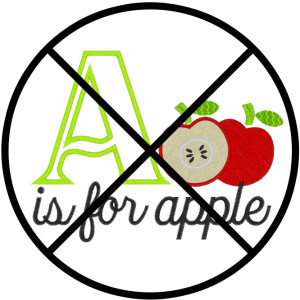 READING: First we start with phonics. We learn the 72 phonograms by sight WITHOUT visual aids. We have used audio aids on some of the harder ones. However, I’m not sure if that will hinder them in the long run. When you give a visual or audio aid when learning phonics then the child has to first remember the image or aid before they can deduce the basic sound(s). A is for apple, for instance. The child first has to remember Apple, then only one of the three sounds that A makes. So we don’t use any visual aids. They only look at a flashcard with the letter on it.
READING: First we start with phonics. We learn the 72 phonograms by sight WITHOUT visual aids. We have used audio aids on some of the harder ones. However, I’m not sure if that will hinder them in the long run. When you give a visual or audio aid when learning phonics then the child has to first remember the image or aid before they can deduce the basic sound(s). A is for apple, for instance. The child first has to remember Apple, then only one of the three sounds that A makes. So we don’t use any visual aids. They only look at a flashcard with the letter on it.
While our children can sing their alphabet at a very young age we do not introduce the letter names when we are doing phonograms. We call the letters by their phonetic sounds. So instead of calling A by it’s name, we call it by ă, ā, and ä. We call the letter O by it’s phonetic sounds of ŏ, ō, ŭ, and oo.
We introduce phonogram flashcards a few at a time until they are mastered. When the first four are memorized, we add a few more, while still reviewing all the ones we’ve mastered. We start this process in pre-k but we don’t accomplish all 74 basic phonograms until kindergarten usually. Every child is different and I’ve heard of children reading at age 3.
We introduce the first 26 phonograms in this order: o, c, a, d, f, g, s, qu, e, b, h, i, j, k, l, m, n, p, r, t, u, v, w, x, y, and z. Most letters only have one sound, six have two sounds, three have three sounds, and one has four sounds. So the first 26 phonograms have 41 different sounds in total.
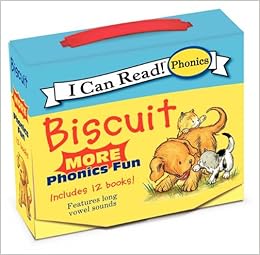 Once the first 26 phonograms are established we start phonics readers. We have the Biscuit Books set and the children really love it. After the Biscuit books we read through some Dick and Jane books, then we start McGuffey’s Pictorial Primer and the readers from Christian Light Publications. Our kindergartener also sits and flips through books or listens to audio books during their “silent reading” time.
Once the first 26 phonograms are established we start phonics readers. We have the Biscuit Books set and the children really love it. After the Biscuit books we read through some Dick and Jane books, then we start McGuffey’s Pictorial Primer and the readers from Christian Light Publications. Our kindergartener also sits and flips through books or listens to audio books during their “silent reading” time.
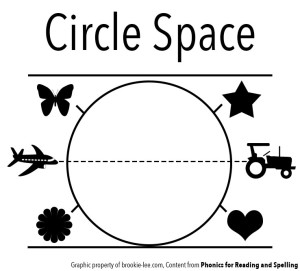
WRITING: Once the child has mastered how to read the first 26 phonograms we start on learning to write the letters. We learn to write in the same order that we learned to read. We use a curriculum called Phonics for Reading and Spelling. In it there are charts and one of them is called the Circle Space. We used the Circle Space and especially the star station in learning to write letters.
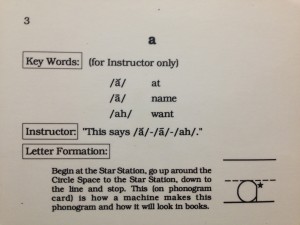 The curriculum flashcards can be purchased separately from the whole system. On the front of the card is the letter. And on the back of each card are instructions on how to say the sounds of the letter, sample words the sounds are in, and letter formation verbiage. To the right is a picture of the back of our flashcard for letter A. These are invaluable to me as a teacher and have made teaching to read and write simple without a lot of book work.
The curriculum flashcards can be purchased separately from the whole system. On the front of the card is the letter. And on the back of each card are instructions on how to say the sounds of the letter, sample words the sounds are in, and letter formation verbiage. To the right is a picture of the back of our flashcard for letter A. These are invaluable to me as a teacher and have made teaching to read and write simple without a lot of book work.
Using these stations has made explaining letter writing very simple. And there are names for each of the lines as well. It makes it fun and easy to learn the rules of penmanship. It also makes it very simple for me to correct letter formation in higher grades. I’m often telling my 1st grader not to let his letters touch the poison line.

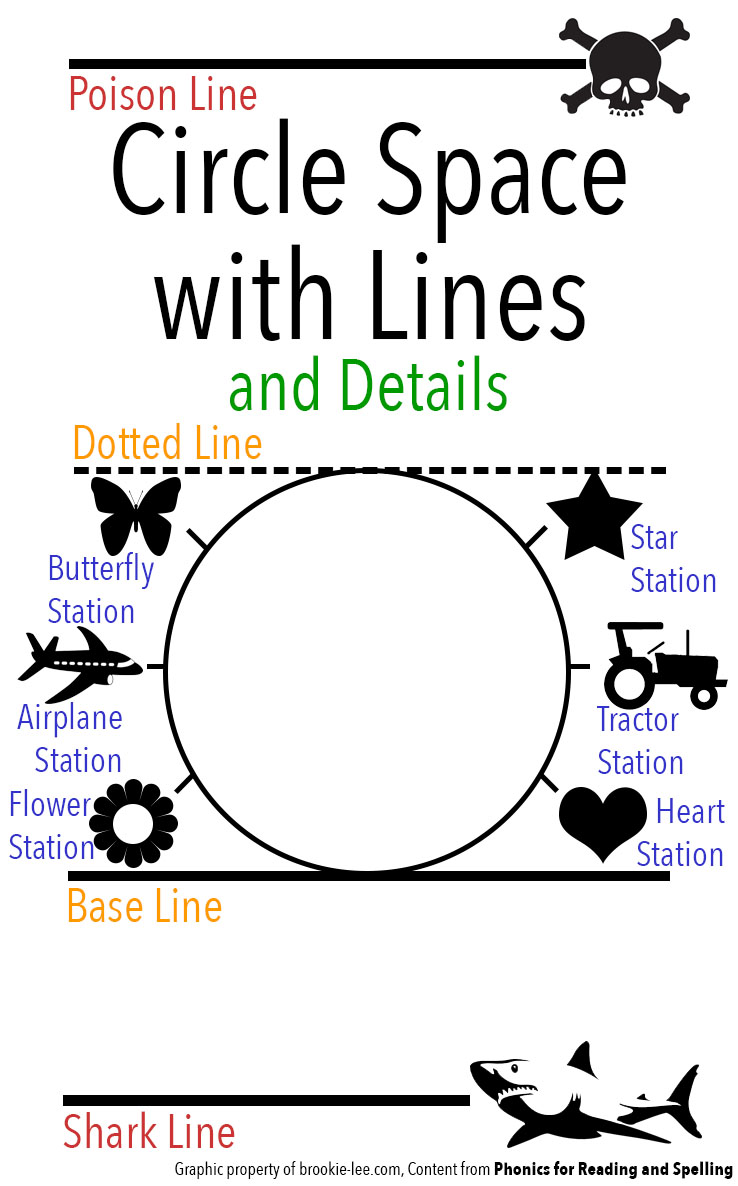
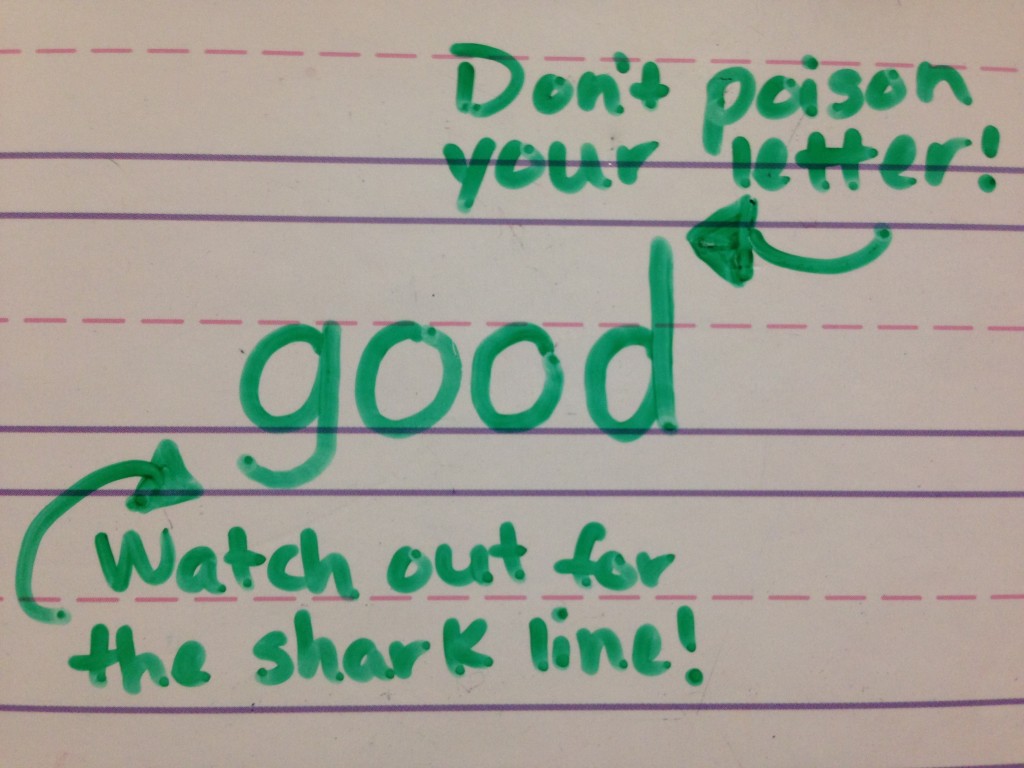
After learning how to write each letter, I continue using the line names and circle space stations in corrections as the children write. It’s very important in the beginning to watch them as they write during “writing time”. You do not allow them to form bad habits. You watch how they are holding their pencil, guide them as needed(watch out for the shark line), and erase and repeat if mistakes are made. I do not correct their penmanship in other subjects.
ARITHMETIC: We use Math-U-See and we all really like it. “Math-U-See is designed to teach students specific skills that build as the student progresses. This systematic and cumulative approach uses a definite, logical sequence of concept instruction. The Math-U-See system is structured with step-by-step procedures for introducing, reviewing, practicing, and mastering concepts. Each lesson teaches using multi-sensory tools such as videos, manipulatives, and other resources, designed to appeal to any type of learner.”
 At our house the child sits and watches the video. We do the first worksheet together to make sure instructions are understood and the concept is established. Then they do the rest of the worksheets on their own over a week. If they have questions they ask. I grade their worksheets each day and they have to go back and correct any mistakes. That helps me, as the teacher, catch if they are not understanding the concept since I’m working with several of my children while they are doing their math worksheets.
At our house the child sits and watches the video. We do the first worksheet together to make sure instructions are understood and the concept is established. Then they do the rest of the worksheets on their own over a week. If they have questions they ask. I grade their worksheets each day and they have to go back and correct any mistakes. That helps me, as the teacher, catch if they are not understanding the concept since I’m working with several of my children while they are doing their math worksheets.
MORE: We also do piano lessons, crafts, and my kindergartener is invited to sit into my older children’s history, science, and literature lessons and experiments/activities. One day a week they attend the Discovery Homeschool Academy and at the end of the year our little kindergartener has a graduation! He loved it!

| Kindergarten Daily | ||
| Math 30mn | Writing 15mn | Piano 30mn |
| Phonics 15mn | Verbal Reading 15mn | Req Reading 15mn |
| Optional | ||
| Science | History | Literature |
| Music History | Art History | Art/Crafts |
Check out my curriculum post for last 2012-2013 school year for a full list of what we used. And here are links for information on how I teach preschool and elementary.

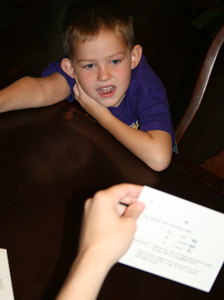
This is a great and informative post. I love hearing about how other homeschooling families organize their days. I was looking at the Phonics and Spelling curriculum and found a few reviews saying that it was “boring”, “dry”, and “complicated”. Have you found any of that to be true? I think that it might be a good fit but those reviews have me questioning it now.
The curriculum comes in a 3 inch three ring binder. It’s very plain but it teaches you how to teach. The value that I find in the curriculum are the phonics cards with the penmanship instructions on each card and the phonetic sounds, along with the extensive 1000+ spelling words with spelling rules and charts to explain spelling rules. There are also additional spelling tests you can give your child to see what level your child is spelling on. It’s not colorful, it doesn’t have cartoon characters or anything fun like that. It’s the core to reading, writing, and spelling. I use dry erase boards with my children when teaching the writing, play a step on the right flashcard game when mastering the phonograms, and use the Super Speller app on the iPad for fun with our custom spelling words from the curriculum. So the curriculum gave me the core information that I needed to teach and we do fun things to enhance it. I prefer it this way. Many curriculums have the core mixed into all the fluff. With four children I don’t have time for fluff. We need to learn to read, write, and spell efficiently so we can get to the fun stuff like crafts, literature, and history. 😀 (In the appendix it includes how to teach months, days, states, capitals, and even latin roots.)
It’s so hard to try and sift through all of the curriculum online to find the perfect one. I’ve noticed the “fluff” in a lot of the samples that I’ve been looking at and some of it seems um….silly? I have four littles too and I’m finding that we can become so easily distracted during our day. I think this approach would be great for us. Thanks so much!